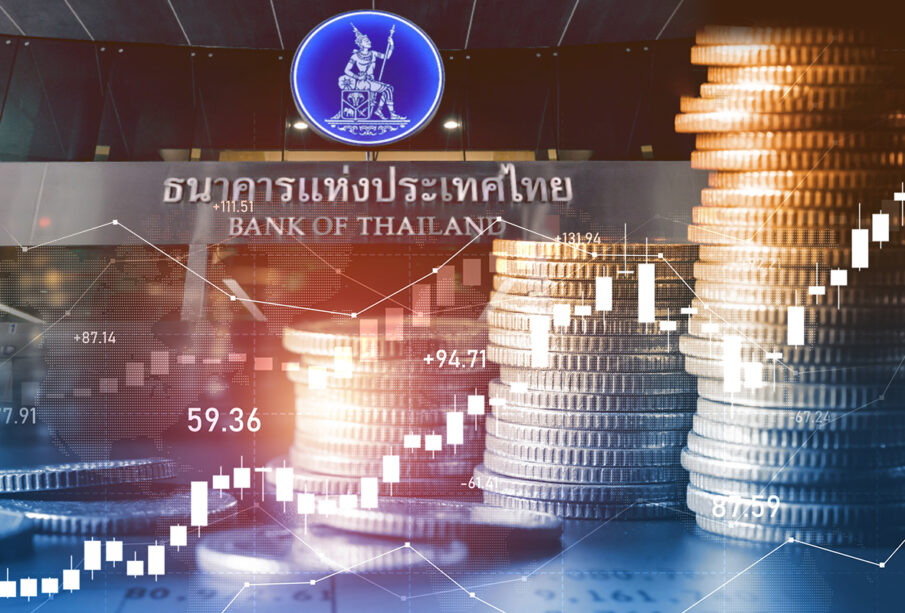Thailand embraces easing stance as trade war ravages growth
The Bank of Thailand (BOT) cut its key interest rate and said it stands ready to ease monetary policy further as the global trade war prompts a sharp downgrade in the outlook for economic growth.
The BOT’s seven-member Monetary Policy Committee voted 5-2 to lower the one-day repurchase rate by a quarter point to 1.75%, the lowest level in two years, as predicted by 17 of 21 economists surveyed by Bloomberg.
“Monetary policy needs to be more accommodative,” BOT Assistant Governor Sakkapop Panyanukul said at a briefing Wednesday after the decision. “We have shifted our policy stance to easing.”
The BOT delivered its first back-to-back rate cut since 2020, taking the cumulative reductions since October to 75 basis points. While Sakkapop said the BOT’s statements don’t imply it’s in an easing “cycle”, the central bank’s tone was more dovish from after its rate cuts in October and February, when it said it would keep a “high bar” for further cuts.
It also shows the urgency of the BOT’s response as the US threatens 36% tariffs on Thai exports, with policymakers deciding to act now despite previously saying they would preserve their limited policy space for a “quite substantial” shock.
“The US trade policies and potential retaliations from major economies will cause significant changes in the global economic, financial, and trade landscape,” the central bank said in its monetary policy statement. “The Thai economy is projected to expand at a slower pace than anticipated, with more downside risks due to uncertainty in major economies’ trade policies and a decline in the number of tourists.”
The Thai central bank made deep cuts to its outlook for gross domestic product growth this year, considering two possible scenarios depending on how US tariff negotiations go.
GDP growth will likely come in at approximately 2% this year if the US sticks with its baseline 10% tariff on all countries and China gets a lower 54% levy after the 90-day pause, the BOT said. That’s well below the 2.9% estimate the central bank set in December and less than even its downward revision of 2.5% in February.
In an alternative scenario, where countries get half of their threatened tariffs and China faces a 72.5% levy, GDP growth could fall to as low as 1.3% — the slowest pace since the pandemic. The BOT did not provide a scenario should the US retain its planned 36% tariff on Thai goods.
“The BOT may want to wait until the government concludes its trade negotiations with the US”, likely choosing to stand pat in June then lowering the key rate by another 25 basis points in the third quarter, Standard Chartered plc economist Tim Leelahaphan said.
To avert high US tariffs, Prime Minister Paetongtarn Shinawatra’s administration has offered to step up imports of US commodities like corn, natural gas and ethane, besides reducing import duties and removing non-tariff barriers to secure a deal. The US is Thailand’s largest export market, with US$55 billion in outbound shipments in 2024.
BOT Governor Sethaput Suthiwartnarueput said that Thailand faces a “storm” from the intensifying global trade war, and that policymakers must focus on stability. Moody’s Ratings also changed the outlook on Thailand’s Baa1 credit rating to negative from stable, citing the deteriorating outlook.
The rate-setting panel said overall financial conditions remain tight, with loan growth and credit quality continuing to deteriorate, especially in housing loans and business loans facing structural issues. The BOT called on banks to pass on the rate reduction to customers, as they normally pass on only half the cut, Sakkapop said.
Cooling prices will help give policymakers elbow room to ease monetary policy. Headline inflation will likely fall below the target range amid lower global crude oil prices and government measures to help alleviate living costs, the BOT said. Core inflation is also likely to remain stable.
Policy will be set “to align with the economic and inflation outlook and associated risks”, it said.
Still, with the key rate at 1.75%, “our policy space is not much”, Sakkapop said, adding that the lowest the key rate reached was 0.5% during the pandemic. “We will need to use it effectively.”





